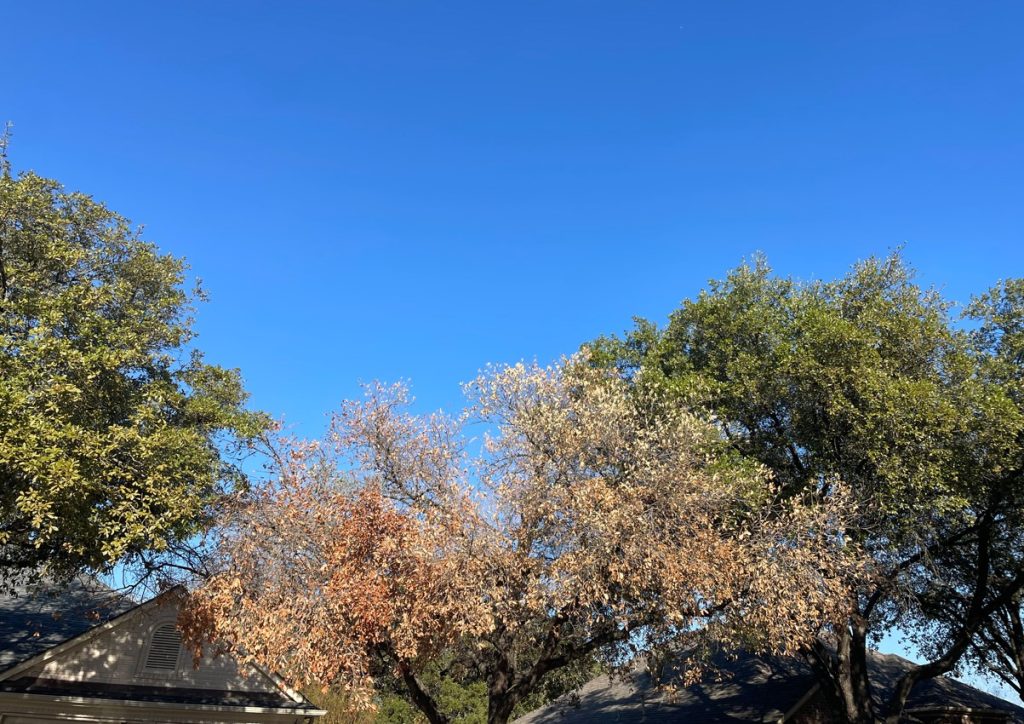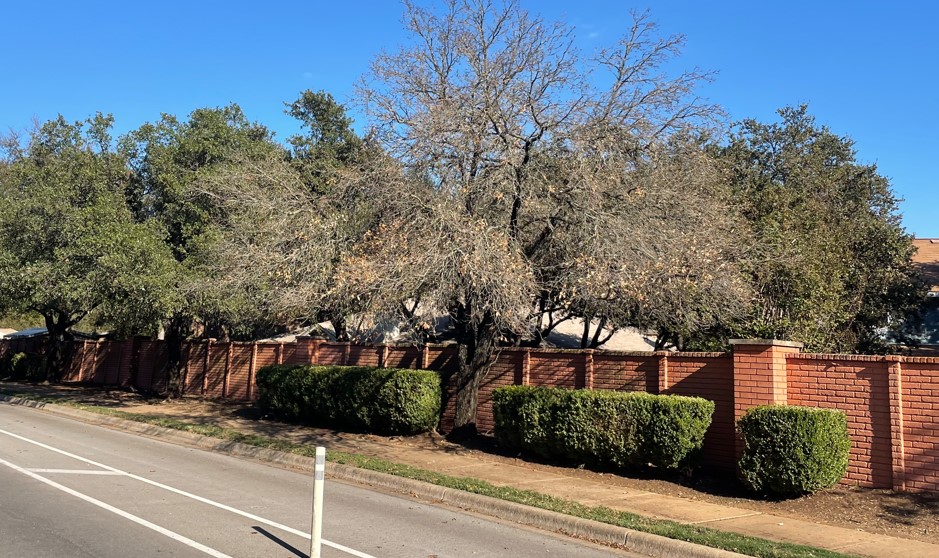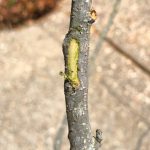I’m definitely seeing an abnormal amount of live oaks declining or outright dying this fall. More so than even last year, when we were much drier. So what’s the cause? Many homeowners are contacting me wondering if they have oak wilt. This is the usual concern whenever a homeowner sees an oak on their property that does not look normal. The good news for these folks is that so far none of the ones I seen this fall that look like this have oak wilt. Here are some pictures of the primary way I am seeing these trees present:

Dying Live Oak – Photo A

Dying Live Oak – Photo B

Healthy Cambium – Photo C
Notice that in both photos, all of the remaining leaves are brown. I expect most trees in this condition to die, if they’re not already dead. A good way to test is to scrape the bark on some of the smaller branches where the bark is thin. If the tissue immediately under the outer bark (the cambium area) is a bright greenish color (Photo C) that part of the tree is alive and healthy. This does not mean the entire branch is healthy, just the branch up to the point where you test the tissue. It could be dead beyond that (towards the tips), or other branches in the canopy could be dead. So testing in several spots is necessary for a fuller assessment. If the cambium tissue is brown, that part of the tree is dead. If it is a pale yellow, then it’s alive but doing poorly, and most likely will die. Be aware that these inner bark colors are those you’d find on small live oak branches. A greenish cambium region is common on many other species but not all. And on larger live oak branches, a healthy inner bark will be a rusty reddish color.
There are actually still some green leaves on the tree in Photo B, but they are on the back side, low on the canopy, and not visible in the photo. This is another common way in which stressed trees are presenting this fall; some sections of the canopy are completely brown, and others are full of healthy leaves.
The third most common symptom I’m seeing this fall is live oaks with most of the canopy having discolored leaves, green but mottled, as they would look in January and February when they normally start to fall, but this symptom started appearing in October, along with significant defoliation. This is in contrast to the completely brown trees, which are holding their leaves.
When trying to determine if this is a fungal disease like oak wilt, it is helpful to look at the pattern of decline or dieback both within the tree and within nearby trees of the same species. Notice in A and B, there are very healthy-looking live oaks surrounding the trees in question. While oak wilt is capable of killing quite quickly and can kill one tree while adjacent ones look asymptomatic, usually by the time an arborist has been called out a couple months have passed, and by then symptoms are usually present in at least part of a nearby oak. This means it is highly unlikely that these trees have oak wilt.
Also, oak wilt usually has a quite obvious leaf symptom. While not always present, what is called veinal necrosis (see my oak wilt page) is present the vast majority of the time, especially on a tree that still has some green leaves. And even on a totally dead and defoliated tree, the leaf symptom will persist in fallen leaves for many months (although one shouldn’t use leaves on the ground as solid proof of infection for a nearby tree).
So if it’s not oak wilt, what is wrong with these trees? Regarding those with leaves that are somewhat mottled and defoliating, there are several other fungal diseases that could cause this. But these diseases tend to have some specific symptoms that I won’t go into here, since they are not present on the trees in question. Between a large number of these trees, and a large number of that are totally brown and a large number that are part brown and part green, I’m leaning towards an abiotic cause.
In 2023 we saw a great amount of stress due to the ice storm we had. Although this did not result in much dieback (as in 2021), but instead lots of breakage, the stress was compounded by the severe drought we had later that year, it being the hottest year on record in over 125 years, (though it was not a record for 100+ degree days) and about 10 inches below normal rainfall. I certainly saw lots dead, dying and stressed trees last year, many of them oaks (and pecans).
But as I said, I think I’ve seen even more of them this year. Why? I believe it is due to drought, and the timing of it and high temperatures. While we had far fewer 100 degree days this year, we had an exceptionally dry fall. And while we had an abnormal amount of rain in July, for the year we are running about a six inch deficit to date. Not as bad as last year, but I think the combination of no rain and very high temps in September and October are the reason for the higher number of stressed trees I am seeing. And we could definitely be seeing a run-on effect, where trees are still struggling from last year. Add to that a period of temps in the teens this past January, and it all adds up.
Fall is often when we see a lot of root growth on trees. If we’re having record drought and temps at that time (this Sept. was 10th hottest & 11th driest on record, Oct. was the hottest & 2nd driest on record per NWS), it could easily spell disaster for trees, especially if they had a big flush of abnormal foliage production in July that would increase their subsequent water needs even more.
Unfortunately, there is not much that can be done for these trees, especially the all brown ones. As I said, I think those are firewood. But for the ones that are mostly green, or mostly defoliated with green cambium in the twigs, watering once a week will be beneficial, unless we have gotten at least a half inch of rain that week. But do not over-water. That can be as bad as too little water. I also strongly recommend against fertilizing, unless a specific nutrient deficiency has been identified. Fertilizing stressed trees can often cause them to succumb to disease and/or death.
If you are interested in a consultation, give me a call.
